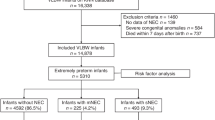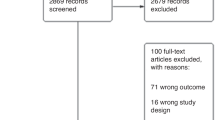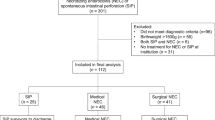ABSTRACT
Objective
To characterize the presentation, management and outcomes of infants with necrotizing enterocolitis totalis (tNEC) vs surgical non-totalis NEC (sNEC).
Study design
This retrospective study identified infants undergoing surgery for NEC through The Children’s Hospitals Neonatal Database. Demographic, surgical and mortality characteristics were compared.
Results
Of 1059 infants, 161 (15.2%) had tNEC. Perinatal characteristics did not differ. tNEC infants were older and were less likely to have pneumoperitoneum at referral (5.6% vs 13.1%, p < 0.001) or intestinal perforation at surgery (38.5% vs 66.7%, p < 0.001). Infants with tNEC were more acidotic preoperatively (7.1, [IQR 7, 7.3] vs 7.3, [IQR 7.2, 7.4], p < 0.001). Mortality was 96.9% for tNEC and 26.5% for sNEC (p < 0.001). tNEC cases varied by center, accounting for 0–43% of all surgical NEC cases.
Conclusions
Mortality is high for tNEC infants, who present at older age, with greater illness severity but are less likely to have intestinal perforation than sNEC infants.
This is a preview of subscription content, access via your institution
Access options
Subscribe to this journal
Receive 12 print issues and online access
$259.00 per year
only $21.58 per issue
Buy this article
- Purchase on SpringerLink
- Instant access to full article PDF
Prices may be subject to local taxes which are calculated during checkout



Similar content being viewed by others
References
Jacob J, Kamitsuka M, Clark RH, Kelleher AS, Spitzer AR. Etiologies of NICU deaths. Pediatrics. 2015;135:e59–65.
Dukleska K, Devin CL, Martin AE, Miller JM, Sullivan KM, Levy C, et al. Necrotizing enterocolitis totalis: high mortality in the absence of an aggressive surgical approach. Surgery. 2019;165:1176–81.
Murthy K, Yanowitz TD, DiGeronimo R, Dykes FD, Zaniletti I, Sharma J, et al. Short-term outcomes for preterm infants with surgical necrotizing enterocolitis. J Perinatol. 2014;34:736–40.
Voss M, Moore SW, van der Merwe I, Pieper C. Fulminanting necrotising enterocolitis: outcome and prognostic factors. Pediatr Surg Int. 1998;13:576–80.
Clark RH, Gordon P, Walker WM, Laughon M, Smith PB, Spitzer AR. Characteristics of patients who die of necrotizing enterocolitis. J Perinatol. 2012;32:199–204.
Rose AT, Patel RM. A critical analysis of risk factors for necrotizing enterocolitis. Semin Fetal Neonatal Med. 2018;23:374–9.
Thompson A, Bizzarro M, Yu S, Diefenbach K, Simpson BJ, Moss RL. Risk factors for necrotizing enterocolitis totalis: a case-control study. J Perinatol. 2011;31:730–8.
Sho S, Neal MD, Sperry J, Hackam DJ. A novel scoring system to predict the development of necrotizing enterocolitis totalis in premature infants. J Pediatr Surg. 2014;49:1053–6.
Pet GC, McAdams RM, Melzer L, Oron AP, Horslen SP, Goldin A, et al. Attitudes surrounding the management of neonates with severe necrotizing enterocolitis. J Pediatr. 2018;199:186–93.e183.
Pyle AK, Shabanova V, Cleary MA, Ozgediz D, Cummings CL, Kamin DS, et al. Variable management strategies for NEC totalis: a national survey. J Perinatol. 2019;39:1521–7.
Han SM, Knell J, Henry O, Riley H, Hong CR, Staffa SJ, et al. Long-term outcomes of severe surgical necrotizing enterocolitis. J Pediatr Surg. 2020;55:848–51.
Murthy K, Dykes FD, Padula MA, Pallotto EK, Reber KM, Durand DJ, et al. The Children’s Hospitals Neonatal Database: an overview of patient complexity, outcomes and variation in care. J Perinatol. 2014;34:582–6.
Olsen IE, Groveman SA, Lawson ML, Clark RH, Zemel BS. New intrauterine growth curves based on United States data. Pediatrics. 2010;125:e214–24.
Moss RL, Kalish LA, Duggan C, Johnston P, Brandt ML, Dunn JCY, et al. Clinical parameters do not adequately predict outcome in necrotizing enterocolitis: a multi-institutional study. J Perinatol. 2008;28:665–74.
Bhatt D, Travers C, Patel RM, Shinnick J, Arps K, Keene S, et al. Predicting mortality or intestinal failure in infants with surgical necrotizing enterocolitis. J Pediatr. 2017;191:22–27.e23.
Henry MC, Lawrence, Moss R. Surgical therapy for necrotizing enterocolitis: bringing evidence to the bedside. Semin Pediatr Surg. 2005;14:181–90.
Yanowitz TD, Sullivan KM, Piazza AJ, Brozanski B, Zaniletti I, Sharma J, et al. Does the initial surgery for necrotizing enterocolitis matter? Comparative outcomes for laparotomy vs. peritoneal drain as initial surgery for necrotizing enterocolitis in infants <1000g birth weight. J Pediatr Surg. 2019;54:712–7.
Gordon PV, Clark R, Swanson JR, Spitzer A. Can a national dataset generate a nomogram for necrotizing enterocolitis onset? J Perinatol. 2014;34:732–5.
Wolf MF, Rose AT, Goel R, Canvasser J, Stoll BJ, Patel RM. Infant Mortality in the United States due to Necrotizing Enterocolits, 1999-2017: Trends and Racial & Geographic Disparities (abstract 3378532). Pediatric Academic Societies 2020; Philadelphia, PA.
Rysavy MA, Li L, Bell EF, Das A, Hintz SR, Stoll BJ, et al. Between-hospital variation in treatment and outcomes in extremely preterm infants. N. Engl J Med. 2015;372:1801–11.
Sparks EA, Khan FA, Fisher JG, Fullerton BS, Hall A, Raphael BP, et al. Necrotizing enterocolitis is associated with earlier achievement of enteral autonomy in children with short bowel syndrome. J Pediatr Surg. 2016;51:92–95.
Khan FA, Squires RH, Litman HJ, Balint J, Carter BA, Fisher JG, et al. Predictors of enteral autonomy in children with intestinal failure: a multicenter cohort study. J Pediatr. 2015;167:29–34.e21.
Gadepalli SK, Canvasser J, Eskenazi Y, Quinn M, Kim JH, Gephart SM. Roles and experiences of parents in necrotizing enterocolitis: an international survey of parental perspectives of communication in the NICU. Adv Neonatal Care. 2017;17:489–98.
Webbe JWH, Duffy JMN, Afonso E, Al-Muzaffar I, Brunton G, Greenough A, et al. Core outcomes in neonatology: development of a core outcome set for neonatal research. Arch Dis Child Fetal Neonatal Ed. 2020;105:425–31.
Acknowledgements
We are most grateful to Ira Adams-Chapman, MD. She contributed extensively with her fund of knowledge and professional mentorship throughout this project including concept, design, and editing until her premature death on October 27, 2020. We thank Karna Murthy, MD (Ann & Robert H. Lurie Children’s Hospital of Chicago) for his ongoing critical review of this project and Ravi M. Patel, MD, MSc (Emory University School of Medicine) for his critical review of this manuscript. We thank Shira M. Asherman (Emory University School of Medicine) for her editing. We are indebted to the clinicians and institutions that serve the infants and families of the Children’s Hospital’s Neonatal Consortium.
Funding
Supported by Department of Pediatrics at Emory University Fellowship Grant (<20205 > [to Allison T. Rose, MD]).
Author information
Authors and Affiliations
Contributions
ATR and AJP conceptualized and designed the study, interpreted the results, drafted the initial manuscript, reviewed and revised the manuscript, and participated in funding acquisition. IZ participated in study design, data analysis, and reviewed and revised the manuscript. MTS conceptualized and designed the study, reviewed and revised the manuscript. All authors approved the final manuscript as submitted and agree to be accountable for all aspects of the work.
Corresponding author
Ethics declarations
Competing interests
All listed authors declare no real or perceived conflicts of interest with the exception of Isabella Zaniletti, who is an employee of the Children’s Hospital Association, Inc (Overland Park, KS) which designed, launched and maintained the database used in this study from 2012–2016.
Additional information
Publisher’s note Springer Nature remains neutral with regard to jurisdictional claims in published maps and institutional affiliations.
Rights and permissions
About this article
Cite this article
Rose, A.T., Zaniletti, I., Santore, M.T. et al. Characteristics and outcomes of a multi-institution cohort of infants with necrotizing enterocolitis totalis. J Perinatol 42, 440–445 (2022). https://doi.org/10.1038/s41372-021-01191-7
Received:
Revised:
Accepted:
Published:
Issue date:
DOI: https://doi.org/10.1038/s41372-021-01191-7
This article is cited by
-
Short-term postoperative complications in preterm neonates with surgical necrotizing enterocolitis: a multicenter retrospective cohort study
Pediatric Surgery International (2024)



